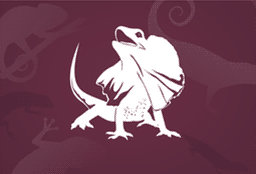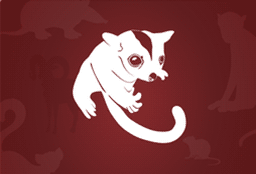Black and white, with the pattern varying across its range. The back of its neck, upper tail and shoulders (on its wings) are white in males and grey in females, and (across most of Australia) the rest of its body is black. In south-eastern, central and south-western Australia, including Tasmania, its back and rump are entirely white. Its eye is red-brown. Young birds are usually grey rather than black and have dark eyes.
Distinctive feature
One toe faces backwards and three face forwards. It has a square-tipped tail.
The adult male is black with a deep-orange to yellow beak, a narrow orange to yellow ring around its eye, and dark legs. The female is grey-brown, with some streaks or mottling, and its back is darker than its belly. The female also has a paler chin than the male, a dull yellow-brown beak, dark legs, and the ring around her eye is less bright. Young birds are also brown but with lighter underparts and a dark grey or black beak.
Size
25 to 28 cm (from head to tail)
A dark grey to black bird with a yellow-tipped red bill, red frontal shield, red legs, and white undertails. Hatchlings are also black with red frontal shield, juveniles have green legs, green horn or black coloured bill, generally paler.
Size
35-40 cm (from head to tail)
This frog goes by several common names: Eastern Banjo Frog, Eastern Pobblebonk Frog and Southern Bullfrog. The first two are based on its distinctive 'bonk' call which sounds similar to the string of a banjo being plucked.
Its back ranges from grey, to olive-green, dark brown or black, with dark marbling or flecks. It has a pale yellow stripe running from under its eye to its arm, a dark band above this, and may also have a pale stripe running down its back. Its sides commonly have a purple or bronze sheen, mottled with black. Its belly is white and sometimes mottled with grey. Its back is warty and rough but its belly is smooth.
Distinctive feature
A prominent gland on the outer side of its hind leg (its shin) and a fleshy lump at the base of each hind foot.
The top of the adult male's head is grey-black, extending in a line down either side of its white breast. Its throat is also white, with a rufous patch in the centre. Its wings and lower back are dark metallic grey and its upper back and underneath are buff. In flight, its white outer tail feathers are visible. The female has similar but duller colouring. A young bird has less distinct markings with dark olive on top of its head, a white chin and throat and a cinnamon chest and belly.
Distinctive feature
It has a very long, fine beak that curves downward.
Grey-brown to bronze, with a dark stripe running along each side of its body from its nostril, across its eye to its tail, getting wider from its front legs. Its body pales below the stripe to a cream belly.
This species has a lighter body with a less obvious stripe running along its sides than the Southern Garden Skink.
Size
8 - 10 cm (nose to end of tail).
Grey-brown to bronze, with a dark stripe running along each side of its body from its nostril, across its eye to its tail, getting wider from its front legs. Its body pales below the stripe to a cream belly.
This species has a ‘heavier’ looking body and a more obvious stripe running along its sides, compared to the Northern Garden Skink.
Size
8 - 10 cm (nose to end of tail).
The adult male has a bright-yellow underbody, olive-green back and wings, and a black head with a bright-yellow collar. Its throat is white, with a broad black band which separates it from the yellow breast. Its beak and legs are black. The adult female has grey upperparts with a pale olive tinge, and is pale grey below with a pale yellowish tinge. Its beak is dark brown and its legs are grey-brown. Both sexes have a red-brown eye. Juvenile birds are rufous above and below, and as they mature, gradually resemble a female, though they retain some rufous feathers in their wings.
A black and white bird, the pattern varies slightly between sexes. The male has a white eyebrow above a black horizontal eye-stripe, a black face and throat, while the female has a white face and throat, with a broad vertical stripe through the eye, and no white eyebrow. Both sexes have a thin white bill and black legs and feet. Juvenile Magpie-larks have a black forehead, white eyebrow and a white throat.
The top of its head and its hindneck are black. Its forehead is covered with bright-yellow skin, which hangs down to form wattles. The rest of the head is white. Its back and wings are pale grey-brown. Below, black plumage extends from the hindneck onto the sides of its breast, and the rest of the underparts are white. Its long legs and feet are reddish and its bill is yellow. It has a prominent spur on each wing.
Juveniles are similar to adults, but have dark ‘scallop’ markings on the back and wings, and the wing spur and wattles are either smaller or absent.
Distinctive feature
A yellow wattle that extends from its forehead to behind its eye and hangs down beside its chin.
A colourful bird, the upper part of its back is bright green, merging to light blue on the lower part to its rump. Its tail is black, tinged with blue, and has two long central feathers (called streamers) that extend beyond the tip of the tail. Its forehead is blue-green and the top of its head is golden. A bold black eye-stripe runs from the base of its beak and is bordered below by a narrow blue line. Its chin is yellow, changing to chestnut on its throat, below which is a broad black band. It has a green breast, becoming paler on the belly and changing to light blue from the lower belly to the vent. It has a long, slim, curved black beak and its legs and feet are grey-black.
Young birds are generally duller and greener. They lack the black band across the lower throat and the long tail streamers.
Distinctive feature
The sexes differ in the length of their tail streamers: the male has longer, more slender streamers.
A tussock-like, rosette plant. Tussock size up to 30 cm high and wide with a flower stalk up to 1 m high.
Leaves
Long, sword-shaped and forming a clump. Each individual leaf is 8 – 20 cm long and 1 – 3 cm wide and usually stands upright. There are 5 veins running down each leaf.
Flowers
Small and initially cream, but turn brown rapidly. They grow on top of a ridged, 1 m high flower stem growing from the centre of the tussock of leaves. The flowers form a tight, cylindrical cluster which is 1 – 7 cm long.
Its genus name Banksia is named after Sir Joseph Banks, a British explorer and naturalist, and its species name marginata is from the Latin 'marginatus' meaning bordered, referring to the recurved leaf edges.
A variable species that occurs as a shrub, a flat-lying plant, or a tree, with smooth brown-grey bark. Grows up to 2 m high and wide as a shrub, less than 1 m as a flat-lying plant, and between 5 – 12 m as a tree.
Leaves
Green on the upper surface and silvery underneath. Each leaf is linear to oblong-shaped, 1 – 8 cm long, 3 – 13 mm wide, and has finely-toothed edges. The edges are recurved (rolled under) and may have small serrations, and their tip can be blunt or squared.
Flowers
Pale yellow cylindrical spikes forming a bottle-brush shape. Each flower head is 5 – 10 cm long and 4 – 6 cm wide and attracts nectar-eating birds.
Fruit/seed:
The southern brown tree frog is native to southern Australia. Other common names of this tree frog are brown tree frog, whistling tree frog, or Ewing's tree frog.
Ranges from pale fawn, cream, or orange to light brown, although some individuals in western Victoria and South Australia are partly or completely green. It has a wide brown band that starts from between its eyes and runs down its back. Darker flecks are also scattered across its back. It has a narrow black or brown stripe that runs from its snout to its shoulder, and a pale stripe that runs from below its eye to the base of its arm. Its belly is white to yellow and breeding males have a light brown vocal sac (beneath their mouth).
Distinctive features
Its back is smooth with small lumps, its fingers have no webbing and its toes are half webbed.
The striped marsh frog or brown-striped frog is a common species in urban habitats It is a mostly aquatic frog native to coastal Eastern Australia.
A pale to grey-brown back with darker brown stripes. Usually also a pale stripe running down the middle of its back. Its belly is white and often flecked with brown, and there are dark spots and stripes on its limbs.
Size
4.5 - 7.5 cm
Grey soft fur, with a white belly and a black stripe that runs from its nose, over its head and along its back. It has a long bushy tail, the last quarter of which is black, often with a white tip. Its ears are large and hairless, and its large eyes are black.
Size
About 28 cm long (from nose to tip of tail).
Also know as Blackthorn.
A woody shrub to small tree, usually with thorny branches. Grows up to 5 – 10 m high.
Leaves
Glabrous, dark green, 20 – 44 mm long and 5 – 9 –mm wide.
Flowers
White, 6 – 10 mm wide, fragrant.
Mostly light blue-grey in colour. The forehead, crown, chin and upper throat are white. It has a long, slim neck and a pointed grey-black bill. The legs are long and dull yellow in colour. Easily identifiable when seen from below with the dark flight feathers of the wing contrasting with the paler grey plumage.
Males and females are similar. When breeding, the birds have long feathers (nuptial plumes) on the head, neck and back. Young are similar in appearance to non-breeding adults, with little to no white on the face; underparts often have a reddish colour.
Distinctive feature
Its characteristic white face.
It has dark brown to black fur with a bright white-stripe at the junction of the body and wings. Some individuals also have an area of white-fur on the chest.
One of the largest insectivorous (microbats) in Australia, it is in the ‘free tail’ family (Molossidae) which have a strong, stiff tail projecting beyond the tail membrane.
The species was formerly classified as Tadarida australis.
Size
85 - 100 mm head and body length; free tail extends 40 to 55 mm from the body. Adult average weight 37 g.
One of Australia's most widespread birds on mainland.Mostly black with a white belly and eyebrow. A young bird has paler, slightly rusty edges to its wing feathers.
Size
18 - 22 cm long (from head to tail)
Dark grey-brown above with some brown streaking. It is paler below with lighter streaks and has a slightly down-curved bill. Young birds are paler.
Distinctive feature
A broad yellow facial stripe across its eye which is bordered with black.





